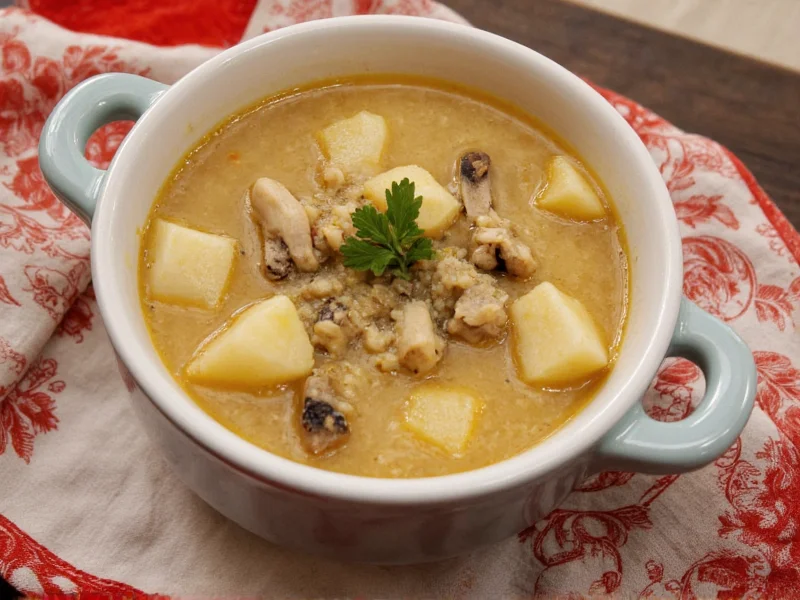Mushroom soups represent one of culinary history's most versatile preparations, evolving from humble peasant fare to sophisticated restaurant specialties. What makes these soups exceptional is their ability to deliver complex umami flavors without meat-based stocks, making them ideal for vegetarian and vegan diets while providing substantial nutritional benefits. Properly prepared mushroom soups showcase the fungi's natural glutamates, creating satisfying depth that rivals traditional bone broth-based preparations.
The Science Behind Mushroom Soup Excellence
Mushrooms contain natural glutamates and guanylate compounds that create synergistic umami when combined. This biochemical reaction explains why mushroom soups develop such profound flavor complexity with minimal ingredients. When mushrooms are properly sautéed before liquid addition, the Maillard reaction creates hundreds of new flavor compounds, transforming simple preparations into extraordinary culinary experiences. The key to maximizing this potential lies in understanding which mushroom varieties contribute specific flavor profiles and textures to soups.
Mushroom Varieties and Their Soup Applications
Not all mushrooms perform equally in soup applications. Each variety brings distinct characteristics that affect final texture, flavor intensity, and visual appeal. Understanding these differences allows home cooks to create balanced, professional-quality mushroom soups consistently.
| Mushroom Variety | Flavor Profile | Best Soup Applications | Preparation Notes |
|---|---|---|---|
| Cremini | Earthy, woodsy, moderate umami | Classic cream soups, rustic preparations | Slice evenly; sauté until deeply browned |
| Shiitake | Robust, smoky, intense umami | Asian-inspired broths, hearty stews | Remove tough stems; slice caps thinly |
| Porcini | Nutty, meaty, complex aroma | Concentrated broths, finishing accents | Rehydrate dried; use soaking liquid |
| Oyster | Delicate, slightly sweet, subtle seafood notes | Elegant bisques, light broths | Add late in cooking; overcooking causes mushiness |
| Morel | Earthy, nutty, complex | Gourmet preparations, special occasion soups | Careful cleaning required; sauté before use |
Mastering Mushroom Soup Techniques
Achieving restaurant-quality mushroom soups requires understanding several critical techniques that transform ordinary preparations into extraordinary dishes. The most crucial step involves proper mushroom preparation—never rinse mushrooms under running water as they absorb liquid like sponges. Instead, use a damp cloth to clean them or a dry brush for wild varieties. For optimal flavor development, slice mushrooms evenly and sauté them in batches to avoid overcrowding the pan, which causes steaming rather than browning.
Building flavor layers creates depth in mushroom soups. Start with aromatic vegetables like shallots and leeks, then add mushrooms in stages—some for immediate flavor, others reserved for texture contrast. Deglaze the pan with dry sherry or white wine to capture fond, then incorporate vegetable stock gradually. For creamy preparations, add dairy or non-dairy alternatives at the end to prevent curdling. The final touch of acid—lemon juice or vinegar—balances richness and brightens flavors.
Nutritional Benefits of Mushroom Soups
Mushroom soups deliver impressive nutritional profiles that extend far beyond simple comfort food. Wild varieties like chanterelles and morels contain significant vitamin D, especially when exposed to sunlight during growth. Cremini and portobello mushrooms provide selenium, supporting immune function, while shiitakes contain lentinan, a compound studied for its immune-modulating properties. A single serving of properly prepared mushroom soup typically contains 3-5 grams of protein, 1-2 grams of fiber, and essential minerals including potassium and copper.
For those following specific dietary patterns, mushroom soups adapt beautifully. Vegan versions achieve creaminess through pureed potatoes or cashews rather than dairy. Low-sodium preparations maintain flavor intensity through proper mushroom selection and cooking techniques. The natural richness of mushrooms means satisfying soups require minimal added fats compared to other creamy preparations, making them suitable for various dietary approaches without sacrificing satisfaction.
Perfecting Your Mushroom Soup Recipe
Creating exceptional mushroom soup requires attention to ingredient quality and timing. Begin with fresh mushrooms showing firm caps and clean gills—avoid any with slimy surfaces or dark spots. For the most flavorful base, combine cultivated and wild mushrooms; even a small amount of dried porcini dramatically enhances depth. When building your soup, remember that mushrooms release substantial liquid as they cook, so start with less stock than you think necessary, adding more only if needed after the mushrooms have fully released their moisture.
Troubleshooting common issues ensures consistent results. If your soup becomes watery, simmer uncovered to reduce excess liquid rather than adding thickeners that alter texture. For bitter flavors, balance with a pinch of sugar or acid rather than masking with cream. When reheating leftovers, add a splash of fresh stock as mushroom soups thicken significantly when chilled. Properly stored in airtight containers, mushroom soups maintain quality for 3-4 days in the refrigerator or up to 3 months when frozen.
Creative Variations and Pairings
Once you've mastered basic mushroom soup techniques, endless creative possibilities emerge. French-inspired preparations incorporate thyme and bay leaf, finished with a touch of cream and fresh parsley. Asian variations feature ginger, garlic, and soy sauce, sometimes with miso paste for additional umami. For elegant presentations, top soups with truffle oil, crispy shallots, or a dollop of crème fraîche.
Mushroom soups pair beautifully with complementary flavors and textures. Crusty bread provides satisfying contrast to smooth preparations, while roasted root vegetables add sweetness that balances earthy mushroom flavors. For wine pairings, select medium-bodied reds like Pinot Noir or earthy whites like Pinot Gris that complement rather than compete with mushroom flavors. When serving as a first course, keep portions modest—6-8 ounces allows the soup to shine without overwhelming subsequent courses.











 浙公网安备
33010002000092号
浙公网安备
33010002000092号 浙B2-20120091-4
浙B2-20120091-4